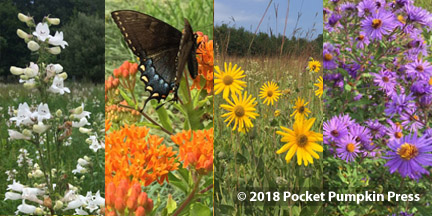z-hub.org > nature > plants |
Plants photos of A Variety of Native Southwest Michigan Plants photos of Spring Woodland Native Wildflowers of Southwest Michigan photos of Prairie Native Wildflowers of Southwest Michigan Plants connect to everything. Plants relate to many natural elements. Plants link to water. Plants need water to live. Plants drink water through their roots. Additionally, plants help to cleanse and purify water that gets polluted by people. Plants connect to land. Their roots are rooted into the soil. The soil provides plants with nutrients. Some plants thrive in moist soil. Some plants thrive in dry soil. Meanwhile, the plants help to stablize the soil. Plants relate to weather, climate, and the seasons. Each plant lives in only a particular climate. Some plants thrive in a hot climate. Some plants thrive in a cold climate. Some plants like a lot of sun. Other plants thrive in the shade. Deciduous plants grow leaves in the spring and drop their leaves in the fall. Plants relate to other plants. Some plants provide shade for other plants. Plants link to animals. Plants provide animals with food and shelter. Animals help to pollinate flowers and to disperse plant seeds. Furthermore, plants provide people with many assets. Plants are beneficial to all social elements. For instance, plants grow fruit, which people eat for nourishment (health) and use in the economy (agriculture). Plants provide people with natural materials, from which to make fire, clothes, shelter, tools, and art. Students learn about many fascinating facts about plants at school and while directly watching plants grow. The government makes laws about plants to try to protect endangered species. Plants provide people with inspiration. People make art about plants. Plants provides people with an opportunity of joy as people walk through the woods and climb trees. Many people cherish and value plants. Furthermore, people affect plants. People base their culture on plants' assets. Either, the culture wisely and sustainably uses plants for society's health, economy, education, freedom, art, and celebrations. Or, the culture abuses, pollutes, and wastes plants by accident or on purpose. Everything connects to everything; thus, plants are related to all social elements (health, economy, school, government, art, values, etc.), culture, and all natural elements (habitats, animals, water, ground, air, etc.). Learn about sustaining nature, click on links below. Southwest Michigan's Sustainable Pursuits Additional Sustainable Pursuits Great Life, Great Culture Imagine a School Learn more about Plants, click on links below. Photos of A Variety of Southwest Michigan Plants Photos of Spring Woodland Wildflowers of Southwest Michigan |
© 2008-2011 Pocket Pumpkin Press, last updated Aprill 2010
Three Oaks, Michigan, USA


